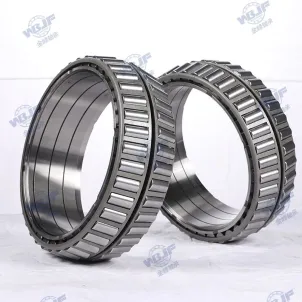How Are Bearings Classified?
Bearings are essential components in modern machinery. Their primary function is to support rotating machinery, reduce friction during motion, and ensure rotational accuracy. Today, let's briefly discuss the classification of bearings.
According to the different friction properties of the moving elements, bearings can be divided into two main categories: rolling bearings and plain bearings.

Commonly used in rolling bearings are deep groove ball bearings, cylindrical roller bearings, and thrust ball bearings. Rolling bearings are typically standardized and serialized, generally consisting of four parts: outer ring, inner ring, rolling elements, and a cage.
Deep groove ball bearings
Deep groove ball bearings mainly bear radial loads but can also withstand both radial and axial loads simultaneously. When only subjected to radial loads, the contact angle is zero. When deep groove ball bearings have a large radial clearance, they exhibit the performance of angular contact bearings and can withstand large axial loads. Deep groove ball bearings have very low friction coefficients and high-speed limits.
Deep groove ball bearings are the most representative rolling bearings and are widely used. They are suitable for high-speed or even extremely high-speed operation, extremely durable, and require minimal maintenance. These bearings have low friction coefficients, high-speed limits, simple structures, low manufacturing costs, and can achieve high manufacturing precision. With diverse size ranges and forms, they are applied in various industries such as precision instruments, low-noise motors, automobiles, motorcycles, and general machinery. They primarily bear radial loads but can also withstand certain amounts of axial loads.
Additional resources:Choosing the Perfect Conveyor Bearings: A Comprehensive Guide
Five Methods and Practical Skills for Bearing Fault Diagnosis

Cylindrical roller bearings
Cylindrical roller bearings have cylindrical rollers as the rolling elements in a radial rolling bearing. The cylindrical rollers and the raceways have line contact. They have a high load-carrying capacity and primarily bear radial loads. Due to low friction between the rollers and the retaining edges, they are suitable for high-speed rotation. Depending on whether there are retaining edges on the raceways, cylindrical roller bearings can be divided into single-row bearings such as NU, NJ, NUP, N, NF, and double-row bearings such as NNU, NN.
Cylindrical roller bearings without retaining edges on the inner or outer rings can allow relative axial movement between the inner and outer rings and can be used as free-end bearings. Bearings with double retaining edges on one side and a single retaining edge on the other can withstand certain directional axial loads. They commonly use stamped steel cages or solid brass cages, although some use molded nylon cages.
Thrust ball bearings
Thrust ball bearings are designed to withstand axial loads during high-speed operation and consist of annular rings with raceway grooves containing ball bearings. Because the rings are seat-shaped, thrust ball bearings are divided into flat seat type and spherical seat type. Additionally, these bearings can withstand axial loads but cannot bear radial loads.
Thrust ball bearings consist of seat rings, shaft rings, and ball retainers. The ring that matches the shaft is called the shaft ring, and the one that matches the housing is called the seat ring. Thrust ball bearings are only suitable for machinery subjected to one-sided axial loads and low speeds, such as crane hooks, vertical pumps, vertical centrifuges, jacks, and low-speed reducers. The shaft rings, seat rings, and rolling elements of these bearings are separable and can be individually assembled and disassembled.



